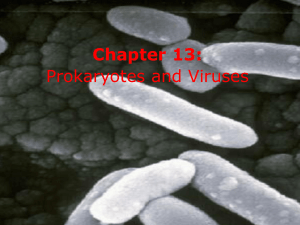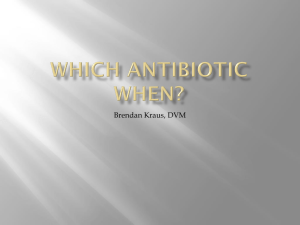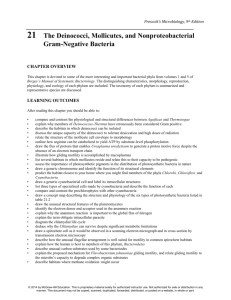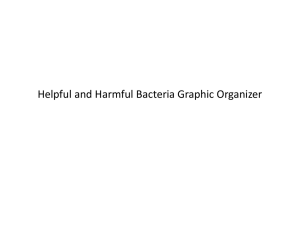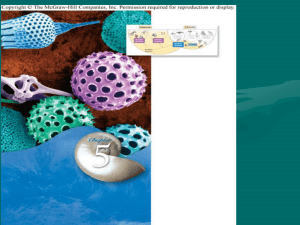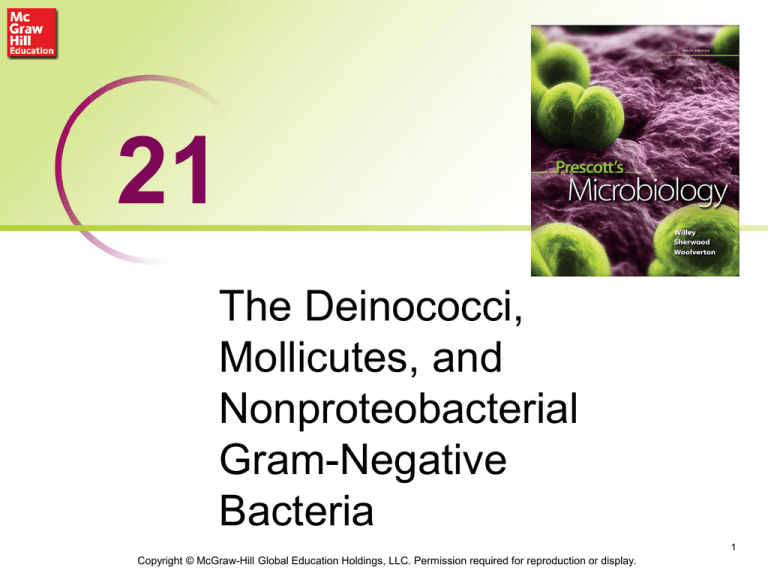
21
The Deinococci,
Mollicutes, and
Nonproteobacterial
Gram-Negative
Bacteria
1
Copyright © McGraw-Hill Global Education Holdings, LLC. Permission required for reproduction or display.
Deinococcus
• Extraordinarily resistant to desiccation and radiation
– can survive 3–5 million rad (100 rad lethal to humans)
• Isolated from ground meat, feces, air, fresh water,
and other sources, but natural habitat unknown
2
Deinococcus
• Genome consists of two circular
chromosomes, a megaplasmid, and a small
plasmid
– radiation resistance due to ability to repair genome
when it is severely damaged
– efficient proteins (protected by manganese) and
enzymes for DNA repair
• Within 12–24 hours can repair chromosomes
fragmented by exposure to radiation
3
The Mycoplasmas
• Lack cell walls and are pleomorphic
– cannot synthesize peptidoglycan precursors
– sterols may stabilize plasma membrane
– smallest bacteria capable of self-reproduction
– grow as fried egg appearance on agar surface
4
More about The Mycoplasmas
• Genomes
– less than 1000 genes
– one of the smallest found in prokaryotes
5
Important Pathogens
• Mycoplasma mycoides – pleuropneumonia in
cattle
• Mycoplasma gallisepticum – chronic respiratory
disease in chickens
• Mycoplasma hyopneumoniae – swine
pneumonia
• Mycoplasma pneumoniae – primary atypical
pneumonia in humans
• Ureaplasma urealyticum – premature birth,
neonatal meningitis and pneumonia
• spiroplasmas – pathogenic in insects, ticks, and
a variety of plants
6
The Photosynthetic Bacteria:
5 Groups
• Cyanobacteria – oxygenic photosynthetic
bacteria
• Anoxygenic phototrophic bacteria:(These
range from photolithoautotrophs to
photoorganoheterotrophs)
– Purple bacteria
– Purple non-sulfur bacteria
– Green non-sulfur bacteria
– Green sulfur bacteria
7
8
Photosynthetic Bacteria
• The cyanobacteria
– carry out oxygenic photosynthesis
• use water as an electron donor and generate
oxygen during photosynthesis
• The purple and green bacteria carry out
anoxygenic photosynthesis and use a
variety of organic and inorganic nutrients for
electron donors (lithotrophs or organotrophs)
and carbon (autotrophs or heterotrophs)
9
Photosynthetic
Microbes
• Differences in
photosynthetic pigments,
with distinct absorption
spectra, and oxygen
requirements are
important ecologically
– inhabit different layers of
water environments
10
The Cyanobacteria
• Largest, most diverse group of photosynthetic
bacteria
– Chlorophyceae – “blue green algae” common term
• Many are obligate photolithoautotrophs; some
can grow slowly in dark as chemoheterotrophs
• Important in nitrogen cycle (provide fertilizer for
cultivation of rice and bean crops)
• Fossil records date back 3.8 million years
• Responsible for the Earth’s atmosphere
• Endosymbiosis leading to eukaryotic plants
• Have chlorophyll a
11
More about Cyanobacteria
• Some storage structures have
– carboxysomes (enzymes for Calvin cycle)
– cyanophycin Range in diameter from ~1 to 10 mm
• May be unicellular, colonial, or filaments
12
More about Cyanobacteria
• Pigmentation
– most appear blue-green due to
presence of phycocyanin
– presence of phycoerythrin in many
ocean isolates gives them red or brown
coloration
– chromatic adaption
• modulation of pigment concentrations in
different light
• Phototaxis by use of gas vacuoles
13
Specialized Reproductive Cells
and Structures
• Binary fission, budding, fragmentation, multiple fission
• Hormogonia
– small, motile fragments of filamentous cyanobacteria
• Akinetes
– dormant, thick-walled resting cells resistant to
desiccation
– often germinate to form new filaments
• Baeocytes
– produced by multiple fission
– small spherical cells; escape when outer wall ruptures
– some are motile by gliding motility
14
Heterocysts
• Specialized cells used for
nitrogen fixation
– produced when organism
is nitrogen deprived
– differentiate from individual
cells in filament
– thick heterocyst wall
prevents O2 diffusion into
heterocyst which would
inactivate nitrogenase
15
Ecology of
Cyanobacteria - 1
• Tolerant of environmental extremes
– thermophilic species can grow at temperatures up to
75°C
– often are primary colonizers
• Can cause blooms in nutrient-rich ponds and lakes
– some produce toxins
16
Ecology of Cyanobacteria - 2
• Often form symbiotic relationships
– e.g., are phototrophic partner in most lichens
– e.g., symbionts with protozoa and fungi
– e.g., nitrogen-fixing species form plant associations
• Profound effect on global carbon cycle
• Synechococcus, Prochlorococcus
– two marine genera; ~1/3 of global CO2 fixation
– less than 1% of ocean mass
17
The Chlamydia
• Obligate intracellular parasites
– must grow and reproduce inside host cells
– although known for ability to cause disease,
many grow within hosts such as protists, and
animal cells without adverse effects
• One class, one order, four families, six
genera
– genus Chlamydia is best studied
18
Genus Chlamydia
• Nonmotile, coccoid, Gram-negative
– cell walls lack muramic acid in peptidoglycan
– have very small genomes
• Obligate intracellular parasites with unique
developmental cycle
– elementary body (EB) attaches to host cell
– reticulate body (RB) reproduction by binary
fission
– differentiate back into EB, lyses cell
19
20
Chlamydial Metabolism
• Cannot catabolize carbohydrates
• Cannot synthesize ATP or NAD+
– import up from host
– do have genes for substrate-level
phosphorylation, electron transport, and
oxidative phosphorylation
• RBs have biosynthetic capabilities when
supplied precursors from host; can
synthesize some amino acids
• EBs seem to be dormant forms
21
Chlamydial diseases
• Chlamydia is the most frequently reported
sexually transmitted bacterial disease
– 1.3 million cases in US in 2010
– number underestimated due to asymptomatic
cases
– Chlamydia trachomatis is the most
commonly isolated species
– transmitted through anal, oral, and vaginal
sex; can also be transmitted from mother to
child during delivery
22
• Clinical manifestations
Chlamydial
diseases
– in males
• asymptomatic or
urethral discharge,
and itching and
inflammation of
genital tract
– in females
• sometimes
asymptomatic
• may cause PID
• if pregnant, can lead
to miscarriage,
stillbirth, inclusion
conjunctivitis, and
infant pneumonia
23
Trachoma
• Caused by C. trachomatis serotypes A-C
• Transmitted by hand-to-hand contact, contact
with infected soaps and towels, and flies, also
mother–child contact in adults
• The greatest single cause of blindness
throughout the world
24
Trachoma
• Clinical manifestations
– first infection
• abrupt onset of inflamed
conjunctiva, leading to
inflammatory cell exudate
and necrotic eyelash follicles
• usually heals spontaneously
– reinfection
• pannus formation (vascularization of cornea),
leading to scarring of conjunctiva
• if scarring of cornea also occurs, blindness results
25
Psittacosis (Ornithosis)
• Caused by Chlamydophilia psittaci
(previously Chlamydia psittaci)
– enters respiratory tract, transported to and
reproduces in liver and spleen, and then
invades lungs
• Infectious disease of birds
– transmitted to humans by direct contact with
infected birds or by inhalation of dried bird
excreta
– occupational hazard in poultry industry
26
Psittacosis
• Clinical manifestations
– inflammation and hemorrhaging of lung tissue
and pneumonia
• Diagnosis
– isolation from blood or sputum, or by serology
• Treatment, prevention, and control
– antibiotic therapy
– chemoprophylaxis for pet birds and poultry
27
Chlamydial Pneumonia
• Caused by Chlamydia pneumoniae
– obligate intracellular parasite
– may also play role in coronary artery disease
and vascular disease at other sites
• Transmission probably human to human by
respiratory secretions
– elementary bodies infect, reticular bodies
replicate
28
Chlamydial Pneumonia
• Clinical manifestations
– fever, productive cough, and mild pharyngitis,
bronchitis, and sinusitis
• Diagnosis, treatment, prevention
– observation of symptoms and a
microimmunofluorescence test
– antibiotic therapy
29
The Spirochaetes
• Contains one class; one
order, three families, 13
genera
• Gram-negative,
chemoheterotrophic
bacteria with distinctive
structure and motility
– slender, long with flexible
helical shape
– creeping (crawling)
motility due to a structure
called an axial filament
• Oxygen requirements vary
30
Symbiotic Associations between
Spirochetes and Other Organisms
• Ecologically diverse
– free living
– symbiotic
• hindguts of termites
• digestive tracts of mollusks and mammals
• oral cavities of animals
– disease
• Lyme disease, syphilis and leptospirosis are
spirochete diseases
31
32
Syphilis
• Caused by Treponema pallidum subsp.
pallidum
• Venereal syphilis – sexually transmitted
• Congenital syphilis – acquired in utero
33
Syphilis
• Diagnosis
– clinical history, microscopic examination, and
serology
• Treatment, prevention, and control
– antibiotic therapy most effective in early
stages
– public education, prompt treatment of new
cases, follow-up on sources and contacts,
sexual hygiene, and use of condoms
34
Lyme Disease
• LD or Lyme borreliosis
• Most common tick-borne
disease in the U.S.
• Caused by Borrelia
burgdorferi (most
common in U.S.), B.
garinii, and B. afzelii
(most common in Europe
and Asia)
35
Lyme Disease
• Transmitted from animal
reservoirs by ticks (Ixodes
scapularis and I. pacificus)
– deer, field mice, and
woodrats
• Complex disease
– clinical manifestations vary
with three stages of
disease
– initial, disseminated, late
stage
36
Stages of Lyme Disease
• Localized stage
– develops 1 week to 10 days after
infection
– expanding, ring-shaped, skin lesion
– flu-like symptoms
• Disseminated stage
– occurs weeks or months after infection
– neurological abnormalities, heart inflammation, and
arthritis
• Lyme arthritis may be autoimmune to joint MHC which
are similar to bacterial antigens
37
Stages of Lyme Disease
• Late stage
– occurs years later
– demyelination of neurons, behavioral changes,
and symptoms resembling Alzheimer’s
disease and multiple sclerosis
38
Lyme Disease
• Diagnosis
– serogical testing (Lyme ELISA or Western
blot)
– isolation of spirochete from patient
– detection of Borrelia DNA (PCR)
• Treatment, prevention, and control
– antibiotic therapy most effective in early
stages
– tick control and avoiding ticks
39
Bacteroides
• Anaerobic, Gram-negative rods, various
shapes
• Often found in oral cavity and intestinal tract
of humans and other animals and the rumen
of ruminants
– often benefit host by degrading complex
carbohydrates, providing extra nutrition to host
– constitute up to 30% of bacteria from human feces
– some cause disease
• Most common nosocomial anaerobic infection
with a 20% fatality rate
40
Gliding Motility - 1
• Characteristic of the Bacteriodetes
• Also present in many other taxa
– fruiting and nonfruiting aerobic
chemoheterotrophs
– cyanobacteria
– green nonsulfur bacteria
– at least two Gram-positive genera
41
Gliding Motility - 2
• Gliding mechanism unknown
– occurs when cells in contact with solid surface
– cells leave slime trail; motility often lost with age
– low-nutrient levels usually stimulate gliding
42
Advantages of Gliding Motility
• Enables cells to encounter insoluble nutrient
sources and digest them with cell bound
digestive enzymes
• Works well in drier habitats (e.g., soil,
sediments, and rotting wood)
• Enables cells to position themselves optimally
for light intensity, [O2], [H2S], temperature,
etc.
43

